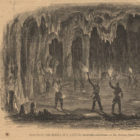July 26 1862: Brief but Deadly Fight at Spangler’s Mill Near Jonesboro
July 26, 1862
Brief but Deadly Fight at Spangler’s Mill
3rd Mich. Cav., Cos. H, L and M, encounter Confederates at the mill near Jonesborough, loosing two killed, five wounded and ten captured in a brief but deadly fight.
Jonesboro (also known as Fort Jonesboro, Jonesborough, and Old Jonesboro) was the first permanent pioneer settlement in Jones Valley. It was established in 1813 by settler John Jones with the help of his brother-in-law Caleb Friley. Together they blazed a wagon trail southeastward from Bear Meat Cabin (Blountsville) on the Huntsville Road, and erected a timber stockade against the possibility of Indian attacks and a smithy.
In March 1862 Samuel Tarrant raised the Jonesboro Guards that mustered at Shelby Springs as Company H of the 28th Alabama Infantry Regiment.
Checking the actual record on this revealed the following:
At daybreak I had gained the Tuscumbia and Chattanooga road, and moved southward on the road leading to La Grange until I came to the county-line road, which I followed until I came to a point about 8 miles south of the Tuscumbia and Chattanooga, where I took a by-road, leading southeastward to the Russellville road; thence to Spangler’s Mill, near which the Moulton and Courtland roads intersect. After I had gained the Russellville road, and when within about one-half mile of the mill, I halted near a school-house, standing in the edge of the woods on the left of the road, send forward Company M, in command of Lieutenant McEntee, for the purpose of making a dash upon the mill, to secure, if possible, a small force of rebel pickets which I had learned were stationed at that point, and after having extended the advance and rear guards a little I ordered my men to dismount. While in this situation I was suddenly apprised of the approach of a column of rebel cavalry, since variously estimated at from 150 to 300 strong. I immediately formed my force, consisting of Companies L and H, in column of squadron in the margin of the woods fronting the enemy’s point of ingress. Scarcely had this movement been effected when the enemy dashed down, formed a line under our fire nearly parallel and not to exceed 6 rods in distance. For about ten minutes the fire from both sides was sharp and withering, both ranks being sensibly thinned. But the enemy still continued to rush down the road in overwhelming numbers, increased their front, and concentrated a fire upon my force, compelling them to give way, which movement was effected in tolerable order at a point about 10 rods in rear of my first position. I partially succeeded in forming a second line on the bank of a ravine, for the purpose of holding the enemy in check until I could rally upon the opposite bank. This I effected under a galling fire, and with a loss, by accident, of several horses and perhaps one or two men. While my men, thus formed, were pouring an irregular fire upon the enemy, Company M, having returned from the mill, formed in the road and poured in volley after volley with terrible effect. This timely and well-executed movement of Lieutenant McEntee diverted the attention of the enemy and gave me time to change my position to the enemy’s left, upon which I advanced with dismounted skirmishers. Meanwhile Lieutenant McEntee, perceiving himself flanked, drew his men off in good order, but was hotly pursued for about 4 miles. He returned by way of the Courtland road.
Finding it impossible to push my men forward to a new engagement I deemed it proper to withdraw, which was done in good order. After proceeding a short distance I came to a by-road leading back to the same point, and induced my men to return again, to look after the wounded, and, if possible, to form a junction with Lieutenant McEntee; but, on coming within sight of the enemy, we were repulsed and forced to retreat for some distance through the woods.
The strength of my command was as follows: Company L, 33; Company H, 24; Company M, 32.
Our loss was 11 men missing and about 20 horses. The loss on the part of the enemy must have been far greater.
G. MOYERS,
Major, Third Michigan Cavalry, Commanding Third Battalion.
Additional events in Alabama for the year 1862 can be viewed here.
